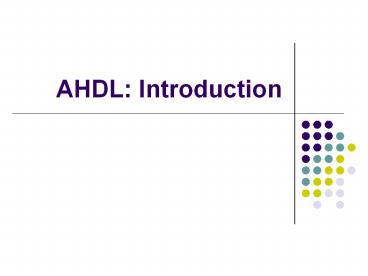AHDL: Introduction - PowerPoint PPT Presentation
1 / 16
Title:
AHDL: Introduction
Description:
AHDL: Introduction Hardware Description Languages Altera hardware description language (AHDL) Very high speed integrated circuit (VHSIC) hardware description language ... – PowerPoint PPT presentation
Number of Views:108
Avg rating:3.0/5.0
Title: AHDL: Introduction
1
AHDL Introduction
2
Hardware Description Languages
- Altera hardware description language (AHDL)
- Very high speed integrated circuit (VHSIC)
hardware description language (VHDL) - Verilog HDL
- Tool MAXPLUS II supports both AHDL and VHDL.
3
HDL Format and Syntax
- The basic format of any hardware circuit
description involves two vital elements - The definition of what goes in and what comes out
of it. (I/O specs) - The definition of how outputs respond to the
inputs. (operation)
Documentation
I/O Definitions
Functional Description
4
AHDL
- The textbook includes information on both AHDL
and VHDL. - We will be discussing only the AHDL format and
syntax for the sake of simplicity.
5
Simple Boolean Expression
- SUBDESIGN and_gate
- (
- a,b INPUT
- y OUTPUT
- )
- BEGIN
- y a b
- END
- Keywords
- SUBDESIGN gives a name to the circuit block.
(Not case-sensitive) - INPUT
- OUTPUT
- BEGIN
- END
6
Basic Boolean Operators
- AND
- OR
- ! NOT
- XOR
7
Intermediate Variables in AHDL
- (Figure 3-49)
- SUBDESIGN fig3_50
- (
- a, b, c INPUT -- define input to block
- y OUTPUT --define block output
- )
- VARIABLE
- m NODE --name an intermediate signal
- BEGIN
- m a b --generate buried product term
- y m c --generate sum on output
- END
- Keyword VARIABLE
- Comments
- Between two s
- After two dashes (--)
8
Representing Data in AHDL
- Numbers
- Binary B101
- Hexadecimal H101
- Decimal 101
- Bit Array/Vectors
- p1 7..0 INPUT --define an 8-bit input port
- Assignment
- VARIABLE temp 7..0 NODE
- BEGIN
- tempp1
- END
9
Define a Truth Table in AHDL
- SUBDESIGN FIG4_50
- (
- a,b,c INPUT --define inputs to block
- y OUTPUT --define block output
- )
- BEGIN
- TABLE
- (a,b,c) gt y --column headings
- (0,0,0) gt 0
- (0,0,1) gt 0
- (0,1,0) gt 0
- (0,1,1) gt 1
- (1,0,0) gt 0
- (1,0,1) gt 1
- (1,1,0) gt 1
- (1,1,1) gt 1
- END TABLE
- END
Keywords TABLE END TABLE
10
Decision Control IF/THEN/ELSE
- SUBDESIGN FIG4_54
- (
- digtal_value3..0 INPUT -- define inputs to
block - z OUTPUT --define block output
- )
- BEGIN
- IF digital_value gt 6 THEN
- z VCC -- output a 1
- ELSE z GND -- output a 0
- END IF
- END
Keywords IF THEN ELSE END IF
11
ELSEIF
- SUBDESIGN fig4_58
- (
- digtal_value3..0 INTPUT --define inputs to
block - too_cold, just_right, too_hot OUTPUT --define
outputs - )
- VARIABLE
- status2..0 NODE --holds state of too_cold,
just_right, too_hot - BEGIN
- IF digital_value lt 8 THEN status b"100"
- ELSEIF digital_value gt 8 AND digital_value lt
11 THEN - status b"010"
- ELSE status b"001"
- END IF
- (too_cold, just_right, too_hot)
status --update output bits - END
12
CASE/WHEN
- SUBDEDSIGN fig4_60
- (
- p,q,r INPUT --define inputs to block
- s OUTPUT --define outputs
- )
- VARIABLE
- status2..0 NODE
- BEGIN
- status (p, q, r) --link input bits in order
- CASE status IS
- WHEN b"100" gt s GND
- WHEN b"101" gt s GND
- WHEN b"110" gt s GND
- WHEN OTHERS gt s VCC
- END CASE
- END
Keywords CASE WHEN OTHERS END CASE
13
The NAND Latch
- SUBDESIGN fig5_61
- (
- sbar, cbar INPUT -- active low inputs
- q, qbar OUTPUT -- allow feedback
- )
- BEGIN
- q !sbar !qbar -- Boolean equations
- qbar !cbar !q
- END
14
AHDL Flip-Flops
- JK, D, SR and latch registers are available for
use in AHDL.
Standard Part Function Primitive Identifier
Clock input clk
Asynchronous preset (active-LOW) prn
Asynchronous clear (active-LOW) clrn
J,K,S,R,D inputs j,k,s,r,d
Level triggered ENABLE input ena
Q output q
15
Single JK Flip-Flop
- SUBDESIGN fig5_64
- (
- jin,kin,clkin,preset,clear INPUT
- qout OUTPUT
- )
- VARIABLE
- ff1 JKFF -- define the FF as JKFF type
- BEGIN
- ff1.prnpreset --optional, default to vcc
- ff1.clrnclear
- ff1.jjin
- ff1.kkin
- ff1.clkclkin
- qoutff1.q
- END
16
MOD 8 Ripple Up Counter
- SUBDESIGN fig5_71
- (
- clock INPUT
- q2..0 OUTPUT
- )
- VARIABLE
- q2..0 JKFF --defines three JK FFs
- BEGIN
- q2..0.j VCC -- toggle mode JK1 for all
FFs - q2..0.k VCC
- q0.clk !clock
- q1.clk !q0.q
- q2.clk !q1.q -- connect clocks in ripple
form - END






























